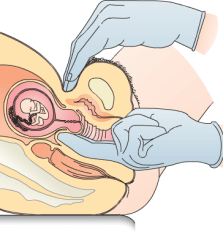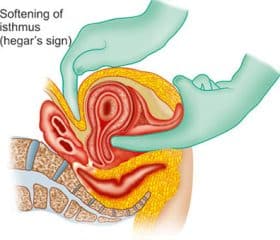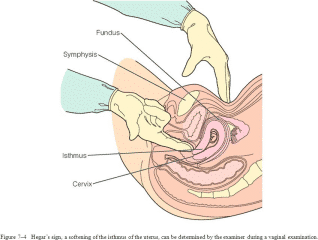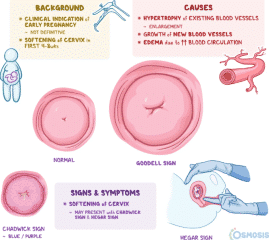This post may contain affiliate links. Read our disclosure policy.
- What is Hegar’s Sign
- What Causes Hegar's Sign?
- How Do You Check for Hegar's Sign?
- What Other Signs Can You Use to Check for Pregnancy?
- Important Facts to Know About Hegar's Sign
Have you ever wondered what kind of signs can you use to know that you are pregnant? Most women ask this, especially those who want to get pregnant.
Quick Facts About Hegar’s Sign
| A | B |
|---|---|
| Definition | Hegar’s Sign is a non-specific indication of pregnancy characterized by the compressibility and softening of the cervical isthmus (area between the cervix and the body of the uterus) |
| Discovery | First described by Ernst Gräfenberg, later popularized by Bernhard von Hegar |
| Presentation | It usually presents between the 4th and 6th week of pregnancy and may be present until the 12th week |
| Causes | Caused by physiological changes in early pregnancy, including increased blood flow and hormonal changes affecting cervical tissue composition |
| Assessment | Can be assessed by a medical professional through a bimanual examination where the consistency of the lower uterine segment may feel soft compared to the body of the uterus situated above and cervix situated below |
| Specificity | It is not a definitive indication of pregnancy, and its absence does not exclude a potential pregnancy |
| Historical Use | Hegar’s sign was one of several methods doctors used to detect pregnancy before reliable blood and urine tests became available |
| Current Relevance | No recent research has assessed how reliable Hegar’s sign is as an indicator of pregnancy. With better tests available, doctors do not usually use Hegar’s sign |
| Related Signs | Other non-specific indications of pregnancy presenting between the 4th and 8th weeks are the Goodell and Chadwick signs. Goodell’s sign is characterized by the softening of the cervical area, while Chadwick’s sign is typically characterized by a bluish discoloration of the cervix, vagina, and vulva due to increased venous blood flow |
| Self-Check | While a person cannot easily perform a test for Hegar’s sign on themselves, they may notice that their cervix feels softer than usual or that the opening feels slightly open if they are familiar with the typical feel and texture of their cervix |
Knowing these pregnancy signs helps so that you can know when to opt in for prenatal care if you want to, so as to make your pregnancy and delivery sail smoothly.
So, for today, Healthsoothe will focus on one of the signs of pregnancy known as hegar’s sign. Hegar’s sign is one of the most common pregnancy signs out there which is easy to detect.
We will explain all there is to know about hegar’s sign, its causes, what it really is, and much more.
So, let’s proceed.
What is Hegar’s Sign

The Hegar’s sign is a non-specific pregnancy indicator defined by the compressibility and softness of the cervical isthmus; that is the part of the cervix between the vaginal portion and the uterus of the cervix.
It usually appears between the 4th and 6th weeks of pregnancy; however, it might appear until the 12th week. The Hegar sign is not a sure marker of pregnancy, but its absence does not rule out the possibility of a pregnancy.
The Chadwick and Goodell signs are non-specific pregnancy symptoms that might appear between the 4th and 8th weeks of pregnancy. The Goodell sign is distinguished by the tenderness of the cervical region.
The Chadwick sign, on the other hand, is distinguished by a blue coloring of the vulva, vagina, and cervix which is caused by an increase in the venous flow of blood to the region.
What Causes Hegar's Sign?

Different physiological changes that take place during the initial six weeks of pregnancy are often responsible for hegar's sign. Increased blood flow, estrogen, progesterone, and prostaglandin production, as well as other biochemical changes, may alter cervical tissue composition in early pregnancy.
These alterations, in particular, often result in a decrease in collagen concentration as well as a rise in dermatan sulfate proteoglycans inside the cervical tissue, leading to softening of the isthmus of the cervix, or Hegar sign.
How Do You Check for Hegar's Sign?

A medical practitioner may physically examine the hegar's sign by doing a bimanual assessment in which 2 fingers of one hand are introduced into the vagina while 2 fingers of the other hand exert pressure outwardly to the abdomen to palpate the lower part of the uterine section1Hiralal, K.(2018). D.C. Dutta's Textbook of Obstetrics (9th ed.). India: Jaypee Brothers Medical Publishers Pvt, Ltd..
During bimanual palpation, the lower uterine segment's consistency may seem mushy in comparison to the uterine body above and the cervix below.2McCann, F. C. (1906). The diagnosis of pregnancy. The Hospital, 41(1050), 88–89.
What Other Signs Can You Use to Check for Pregnancy?
Apart from the hegar’s sign, there are two other signs that denote pregnancy. They are:
- Chadwick sign

Chadwick sign is a bluish discoloration of the cervix3Uldbjerg, N., & Ulmsten, U. (1990). The physiology of cervical ripening and cervical dilatation and the effect of abortifacient drugs. Bailliere's Clinical Obstetrics and Gynaecology, 4(2), 263-282. DOI: 10.1016/S0950-3552(05)80226-3, vagina, and vulva caused by venous congestion4Health Jade Team. Chadwick sign. In Health Jade. Retrieved October 19th, 2022, . Chadwick’s sign can be observed as early as 6-8 weeks5Christiansen, S. (2021). What is Chadwick’s Sign? In Verywell Health. Retrieved Oct 19th, 2022 after conception and is often used as an early sign of pregnancy.
The diagnosis of pregnancy requires a multifaceted approach using 3 main diagnostic tools6Ladinski, L. J. (1907). Diagnosis of early pregnancy with reference to a particular sign. Medical Record (1866-1922), 71(15), 597.. These are history and physical examination, laboratory evaluation, and ultrasonography. Currently, physicians may use all of these tools to diagnose pregnancy at early gestation and to help rule out other pathologies.
Important aspects of the menstrual history must be obtained. The woman should describe her usual menstrual pattern, including the date of onset of last menses, duration, flow, and frequency.
Items that may confuse the diagnosis of early pregnancy are an atypical last menstrual period, contraceptive use, and a history of irregular menses. Additionally, as many as 25% of women bleed during their first trimester, further complicating the assessment.
The classic presentation of pregnancy is a woman with menses of regular frequency who presents with the absence of menstruation (amenorrhea), nausea, vomiting, generalized malaise, and breast tenderness.
Upon physical examination, one may find an enlarged uterus after bimanual examination, breast changes, and softening and enlargement of the cervix (Hegar sign; observed at approximately 6 weeks).
A gravid uterus may be palpable low in the abdomen if the pregnancy has progressed far enough, usually by 12 weeks. Currently, through the use of chemical assays and ultrasonography, physicians are capable of making the diagnosis of pregnancy before many of the physical signs and symptoms are evident.
Several hormones can be measured and monitored to aid in the diagnosis of pregnancy. The most commonly used assays are for the beta subunit of human chorionic gonadotropin (beta hCG). Other hormones that have been used include progesterone and early pregnancy factor.
- Goodell’s sign

Goodell’s sign is an indication of pregnancy7Chong; W.M. (1 January 2001). Cardiology A Socratic Approach. Orient Blackswan. pp. 36–. ISBN 978-81-250-1887-2.. It is a significant softening of the vaginal portion of the cervix.
Important Facts to Know About Hegar's Sign
Hegar's sign is a non-specific pregnancy indicator characterized by cervical isthmus compressibility and softness. Hegar's sign normally appears between the fourth and sixth weeks of pregnancy, however, it may appear as late as the 12th week8Cunningham, Gary (2010). Williams obstetrics: Chapter 8, Prenatal Care (23rd ed.). New York: McGraw-Hill Medical. ISBN 978-0071497015..
Hegar's sign is usually caused by changes in the thickness of the cervical isthmus within the first 6wks of pregnancy. A medical practitioner may physically examine it via bimanual examination, in which the integrity of the lower part of the uterine segment may seem mushy when contrasted to the bulk of the uterus above and the cervix below.9Hamilton Bailey, W. J. Bishop (1944). Notable names in Medicine & Surgery. London: H. K. Lewis & Co. Ltd. p. 101.10D.C.Dutta (2013). D.C.DUTTA'S Textbook of Obstetrics. India: New central book Agency Ltd. p. 65.
All right, guys, that is it for now for hegar’s sign.
Feel free to contact us at contact@healthsoothe.com if you have further questions to ask or if there’s anything you want to contribute or correct to this article.
You can always check our FAQs section below to know more about hegar’s sign.
Frequently Asked Questions About Hegar’s Sign
What Does Positive Hegar Sign Mean?
This post may contain affiliate links. Read our disclosure policy.
A positive hegar's sign is an indication of pregnancy in a woman, specifically the compressibility and softening of the cervical isthmus (the portion of the cervix between the uterus and the vaginal portion of the cervix) and the uterine cervix appearing bluish and engorged.
What is the Difference Between Goodell's sign and Hegar's sign?
This post may contain affiliate links. Read our disclosure policy.
Other early signs of pregnancy include Goodell's sign (a softening of the cervix at around six to eight weeks of gestation) and Hegar's sign (softening of the lower segment of the uterus, which occurs around six to 12 weeks of gestation).
Is Hegar's Sign a Positive Sign of Pregnancy?
This post may contain affiliate links. Read our disclosure policy.
Probable signs of pregnancy are considered to be signs that the examiner can observe. These signs include the Goodell sign, Chadwick sign, Hegar's sign, positive serum and urine samples, Braxton Hicks contractions, and ballottement. Observation of these signs indicates that the woman is most likely pregnant.
Additional resources and citations
- 1Hiralal, K.(2018). D.C. Dutta's Textbook of Obstetrics (9th ed.). India: Jaypee Brothers Medical Publishers Pvt, Ltd.
- 2McCann, F. C. (1906). The diagnosis of pregnancy. The Hospital, 41(1050), 88–89.
- 3Uldbjerg, N., & Ulmsten, U. (1990). The physiology of cervical ripening and cervical dilatation and the effect of abortifacient drugs. Bailliere's Clinical Obstetrics and Gynaecology, 4(2), 263-282. DOI: 10.1016/S0950-3552(05)80226-3
- 4Health Jade Team. Chadwick sign. In Health Jade. Retrieved October 19th, 2022,
- 5Christiansen, S. (2021). What is Chadwick’s Sign? In Verywell Health. Retrieved Oct 19th, 2022
- 6Ladinski, L. J. (1907). Diagnosis of early pregnancy with reference to a particular sign. Medical Record (1866-1922), 71(15), 597.
- 7Chong; W.M. (1 January 2001). Cardiology A Socratic Approach. Orient Blackswan. pp. 36–. ISBN 978-81-250-1887-2.
- 8Cunningham, Gary (2010). Williams obstetrics: Chapter 8, Prenatal Care (23rd ed.). New York: McGraw-Hill Medical. ISBN 978-0071497015.
- 9Hamilton Bailey, W. J. Bishop (1944). Notable names in Medicine & Surgery. London: H. K. Lewis & Co. Ltd. p. 101.
- 10D.C.Dutta (2013). D.C.DUTTA'S Textbook of Obstetrics. India: New central book Agency Ltd. p. 65.



